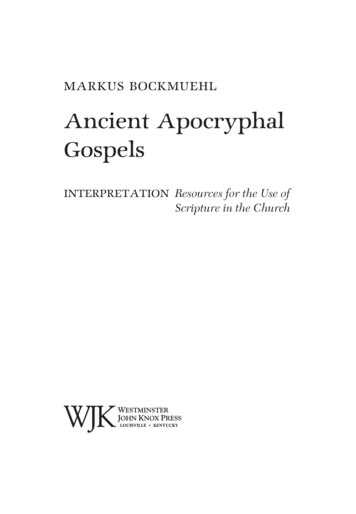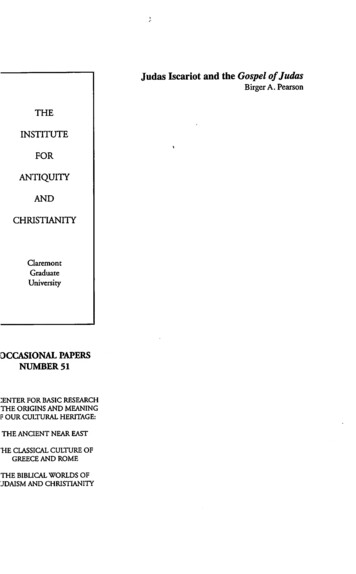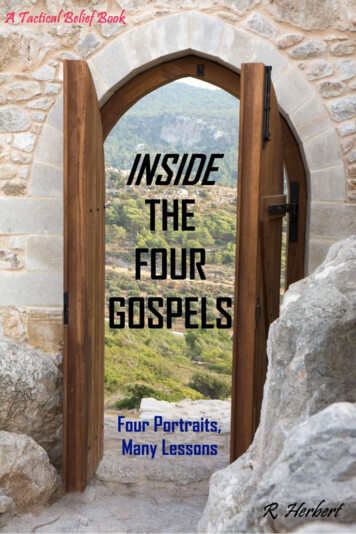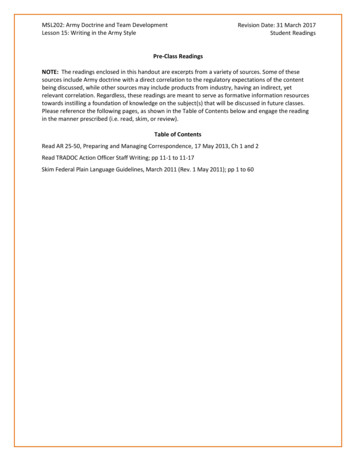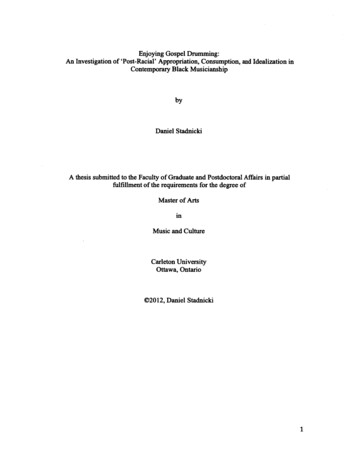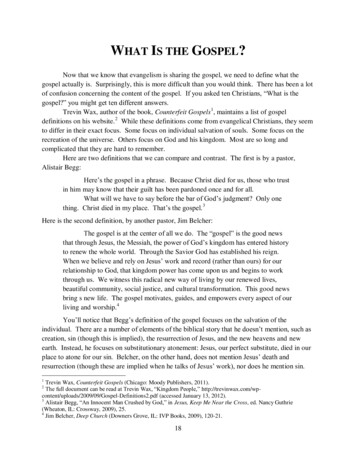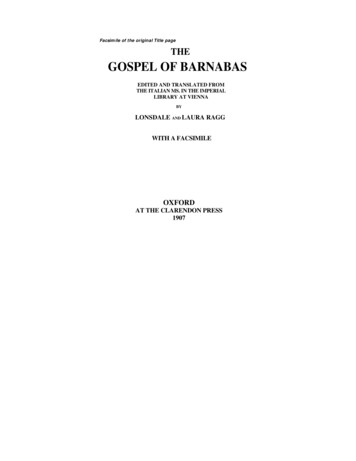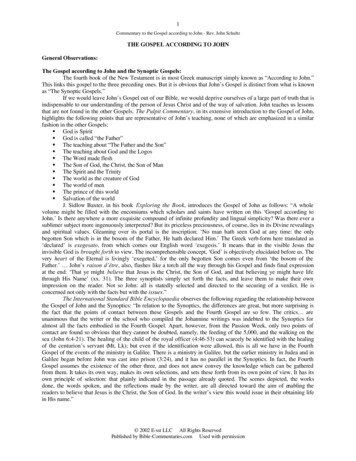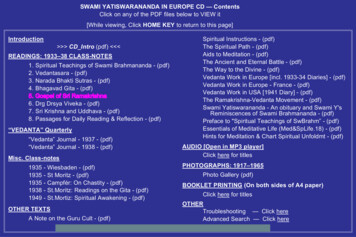
Transcription
SWAMI YATISWARANANDA IN EUROPE CD — ContentsClick on any of the PDF files below to VIEW it[While viewing, Click HOME KEY to return to this page]Introduction CD Intro (pdf) READINGS: 1933–38 CLASS-NOTES1. Spiritual Teachings of Swami Brahmananda - (pdf)2. Vedantasara - (pdf)3. Narada Bhakti Sutras - (pdf)4. Bhagavad Gita - (pdf)5. Gospel of Sri Ramakrishna6. Drg Drsya Viveka - (pdf)7. Sri Krishna and Uddhava - (pdf)8. Passages for Daily Reading & Reflection - (pdf)“VEDANTA” Quarterly“Vedanta” Journal - 1937 - (pdf)“Vedanta” Journal - 1938 - (pdf)Misc. Class-notes1935 - Wiesbaden - (pdf)1935 - St Moritz - (pdf)1935 - Campfér: On Chastity - (pdf)1938 - St.Moritz: Readings on the Gita - (pdf)1949 - St.Mortiz: Spiritual Awakening - (pdf)OTHER TEXTSA Note on the Guru Cult - (pdf)Spiritual Instructions - (pdf)The Spiritual Path - (pdf)Aids to Meditation - (pdf)The Ancient and Eternal Battle - (pdf)The Way to the Divine - (pdf)Vedanta Work in Europe [incl. 1933-34 Diaries] - (pdf)Vedanta Work in Europe - France - (pdf)Vedanta Work in USA [1941 Diary] - (pdf)The Ramakrishna-Vedanta Movement - (pdf)Swami Yatiswarananda - An obituary and Swami Y'sReminiscences of Swami Brahmananda - (pdf)Preface to "Spiritual Teachings of SwBrahm” - (pdf)Essentials of Meditative Life (Med&SpLife.18) - (pdf)Hints for Meditation & Chart Spiritual Unfoldmt - (pdf)AUDIO [Open in MP3 player]Click here for titlesPHOTOGRAPHS: 1917–1965Photo Gallery (pdf)BOOKLET PRINTING (On both sides of A4 paper)Click here for titlesOTHERTroubleshooting — Click hereAdvanced Search — Click here
Swami YatiswaranandaREADINGSONTHE GOSPEL OF SRIRAMAKRISHNAVolume I (Madras 1911)Volume II (Madras 1922)Wiesbaden, GermanyApril 26, 1934 through January 9, 1935Vedanta Study CircleAthens, Greece1994
Published by:John ManettaBeles 28 (Koukaki)GR 117 41 Athens, GreecePhone: [ 30] 210 923 46 82Printed inAthens, GreecePrinting1st —September, 1994Printed to CD— August 2004Processed with:Ventura PublisherTypeset in:Helvetica 10/12
PUBLISHER’S NOTEDear Friends,Further to Swami Yatiswarananda’s READINGS on SWAMI BRAHMANANDA’S SPIRITUAL TEACHINGS, and the READINGS on theVEDANTASARA, the NARADA BHAKTI SUTRAS, the DRG-DRSYAVIVEKA and the BHAGAVAD-GITA, we are happy to share with youSwami Yatiswarananda’s READINGS ON THE GOSPEL OF SRI RAMAKRISHNA VOL. I & II, the notes of class-talks delivered at Wiesbaden, Germany, to an intimate group of European students, from April25, 1934 through January 9, 1935.Our search in Germany for Readings generated between 1933-1938had already revealed a German translation of the Gospel Readings,and we were lucky to find a copy of the English original during our 1993search at Sri Ramakrishna Math, Bangalore, India.Along with the original carbon copies of class-notes, there was also aslightly edited version with topic-titles, compiled by Mr. Wolfram K. Koch(Swami Yatiswarananda’s host at Wiesbaden) apparently intended foreventual publication, which we have verified and supplemented for thepresent publication. In view of its historical interest, we give Mr. Koch’sIntroduction to the Gospel Readings, just after this Publisher’s Note. Itis due to Mr. Koch’s painstaking labour that these notes were manuallytaken down, decoded, verified, and hard copies made for circulationamong the members of the Wiesbaden Group.Vedanta students, of course, already know of MEDITATION ANDSPIRITUAL LIFE, the extensive selection of Swami Yatiswarananda’swritings and talks. The present READINGS on the GOSPEL, naturally,duplicate ideas in the aforementioned book. However, repetition is welcome to the earnest seeker, and it will be especially interesting for Europeans to identify with the actual format of how Vedanta waspioneered in the Europe of 60 years ago!Romain Rolland mentions Swami Yatiswarananda in his diary underdate of May 1st, 1935, when the Swami visited Rolland in Switzerlandtogether with Paul Geheeb. The Swami had already been moving —since November 1933—mainly in Germany and Switzerland [Wiesbaden, Geneva, Lausanne, Zurich, Campfer, St.Moritz, etc.] , and occasionally also to the Hague and Poland. He also visited France severaltimes between 1933 and 1938, and represented the Order at the 1936Ramakrishna Centenary celebrations at the Sorbonne, in Paris.The Readings on the Gospel is the fifth of a series of specific booksstudied ‘live’, and in a particular order, with the European students(whose minds were practically virginal as regards the practical applica-
tions of Vedanta), in order to generate a corpus of material to supportthem—and, why not, even future generations of students—in their spiritual struggle.It is indeed a great good fortune that these READINGS can be consulted by us today. We are sure you will find them both inspiring, andchallenging, like the other Readings generated during the Swami’spre-World War II period in Europe, which are particularly addressed tothe Western student,—who often has a hard time to acquire a correctperspective about what true spiritual life is all about, and then struggleto live as a spiritual athelete amidst a spiritual wilderness, mostly withlittle or no support from any Centre.Daily study of the various Readings, daily study and reflection onparticular scriptural passages, such as later published in THE DIVINELIFE, etc., is repeatedly recommended by the Swami, just to providethe necessary daily support. And the Readings are pretty well self-contained, with plenty of essential quotations from scripture and classicmanuals, etc., which renders them exceedingly lively.The Gospel Volumes I & II (originally published in English from Madras in 1911 and 1922) are those that preceded the full translation ofthe original Bengali, published by Swami Nikhilananda from New York,in 1942. Volume II is out of print, but some Centres may have copies intheir libraries, which one could photocopy. As for Volume I (M.’s originalEnglish) it was reprinted in 1978, and rightly so, for it is indeed ‘doctrinally important’, as Swami Tapasyananda writes in his introduction, and ithas a charm of its own, just like Volume II.Those who may like to parallelly study the Gospel sections will findpage-references leading them to the editions presently in print— in theContents, in the Headers to each day’s Readings and in the Topics inVolume I listed in the Appendix A. There is also an Alphabetical Index ofTopics in the present Readings, and a Gospel History. Paragraph numbering is known to be occasionally erratic.In these Gospel Readings in particular, prophetic reference is madeagain and again to the impending catastrophe of World War II, then just5 years away. This was in the context of the way to combat the severespiritual obstacles of “righteous” indignation, hatred, dislike and aversion, towards brutality and other uncivilized happenings in the then environment—not much different from today’s, though in a different form!PUBLISHER
INTRODUCTIONby Wolfram H. Koch[to Swami Yatiswarananda’s Readings on the Gospel of SriRamakrishna, Vol.I & II (English Editions) delivered atWiesbaden, Germany, in 1934]It is a unique background against which it was Swami Yatiswarananda’s destiny to bring for the first time the message of Sri Ramakrishna to the Europe of 1933.That it was just to Germany of all countries that it was brought,where the chaos following the first World War had grown to its climax,is by no means astonishing. For there, naturally, the yearning for spiritual liberation too had become most poignant.Such an elemental upsurge towards spiritual evolution, as it willhappen now and then on a larger scale in human history, could not butbring about tangible results.Germany, after the catastrophe of the War (World War I) and thegeneral outer and inner breakdown, was being torn asunder by adozen or more ideologies, which, each in its own way fought for priority in people’s minds. Old values had proved to be worthless andnewly invented ones grew exuberantly out of the accumulated mud.It is where the downward pressure is the greatest that the liberatingreaction will one day become the most powerful.Looking back on those years, the comparison with what is happening today (1953) irrepressibly imposes itself on the minds of our generation, and we shall possibly not be too far wrong by expecting that insome not too distant future it may again be in Germany where a newcentre of spiritual realization will be established.Like today, those who could not reconcile themselves with the general course things were taking and who had cultivated a subtler senseof understanding, felt intuitively that all that presented itself to the demoralized, post-inflation society of that time did not bear the mark ofpermanence and liberation which they sought.The result was, that the louder the voices in the streets claimingsome vague ‘freedom of the senses’, the more silent became thosewhose longing went rather in the direction of a ‘freedom from thesenses’ and of religious realization.Their number increased steadily and their hankering found expression when and whenever they met. Those chosen few of a country indissolution contacted one another more or less secretly in many differ-
6Introduction by Wolfram Kochent places, but it was the privilege of a small and quite heterogeneousgroup of ardent students of Truth living in Wiesbaden, the lovely garden-town in the middle of the Taunus-hills, overlooking the Rhine,1 toreceive in their midst the first messenger of the Vedantic Truth as itwas taught by Sri Ramakrishna to modern mankind.Nowadays, the complete Gospel of Sri Ramakrishna, rendered intoEnglish prose from the Bengali original text,2 is being read and commented upon in innumerable lectures, readings and classes in andoutside the Vedanta Centres of the Ramakrishna Order all over theworld.Those first talks in Wiesbaden however, given to a handful of people ready to receive spiritual instruction, will for ever retain the fragrance and the subtle spiritual charm of those unique early days whenSwami Yatiswarananda for the first time, in the intimacy of an old-fashioned drawing-room, began to speak of the Master’s teachings. Noneof those present there could then guess that out of this modest beginning the large centres in London and Paris would come to grow.It was the rare good fortune of Mr. Wolfram H. Koch—theWiesbaden scholar, now well known by his contributions to the readers of periodicals like Prabuddha Bharata and Vedanta for theWest—to have become, almost twenty years ago now, the mouthpieceof this group of friends.At the same time, favoured by outward circumstances, he couldgive special stress to the fervent request he had decided to place before the head of the Ramakrishna Math in India, asking him to sendout a member of the Order who would be willing to give them spiritualinstruction and guidance.The request fell on fruitful soil and Swami Yatiswarananda, then already one of the most advanced members of the Order, was entrustedwith the task of bringing spiritual light into a country in darkness, lacerated as it was by a host of destructive forces.We know through Swami Yatiswarananda’s own mouth that it waswith a heavy heart that he stepped on board the boat that was to takehim to Europe one afternoon in October 1933. He did not yet see hisway quite clearly then, nor was he too optimistic as to the result of thework he was about to undertake.Early next morning however, when he awoke in his cabin, surrounded by the infinite expanse of skies and water, the awareness of1 25Km south-west from Frankfurt, across the Rhine from Mainz.2 By Swami Nikhilananda, first published in 1942.
Introduction by Wolfram Koch7such a blissful Divine Presence came over him that all his doubts wereswept away and he understood that his work would be blessed. It was.In the meantime, the Wiesbaden group of his aspirant devoteesanxiously looked forward to their guru’s arrival. The house in which hewas to live had been made ready to receive him, and all possible arrangements were made to make him feel comfortable.3When finally he arrived on November 8, 1933, all the impatientWesterners immediately started bombarding him with questions concerning their personal problems and difficulties.The Swami’s reaction was quite different from that they had expected it to be, and some amusing reminiscences with respect to it arestill current among the members of that first group: for the Swami observed an unbreakable silence! To all their repeated questions of‘what to do?’, for a long time his sole advice would be: ‘What to do?Pray to the Lord’.This answer, even now after twenty years, has remained proverbialamong those to whom it was given and it is still being quoted whenever the opportunity arises, accompanied by that little wistful smilewith which we pathetically try to hide our nostalgia for happy times, irrevocably lost in the mist of the past.When that past however was still a living present, Swami’s studentsduring the first days or weeks often looked helplessly at each other,wondering whether they would ever receive another answer from theirteacher as far as spiritual matters were concerned. It became a puzzleto all those who had expected him to start instructing, training and initiating them right away and to question them in his turn concerning allthose personal items which they considered necessary for him toknow.His, however, was another method.Time is an important factor, he once remarked, we must wait patiently till he sees his way clearly by the grace of the Lord.So, quietly he waited and thereby taught his devotees their first lesson: patience.Willingly and good-naturedly they surrendered to his will, feelingnot only the power of one whom one of his brother Swamis in the Westused to call a ‘spiritual giant’; they also were strongly aware of his benevolent and loving interest in each of them and of the bond whichhad already been established between guru and disciples.3 The building was destroyed by Allied bombing during World War II.
8Introduction by Wolfram KochSome of them may have suspected that in the meantime theirSwami was contacting the souls and minds of those who had comewithin the circle of his service, using other means for coming to knowmore about them.Till one day, in that same old-fashioned drawing-room, seatedround the middle table, he threw open the gates and the waters ofspiritual knowledge were allowed to flow.Then, finally, in that same old-fashioned drawing-room, seatedround the middle table, he acquainted them with Swami Brahmananda’s—his guru’s —Spiritual TeachingsThe present material is the Swami’s comments on the fifth in the series of books he read with that first group of Vedanta students and followers of the Great Master in Europe, to whom he had been found willing to bring the message of Sri Ramakrishna.He had first introduced his German students into the basic concepts of spiritual practice by reading with them and bringing near tothem the Spiritual Teachings of his own Guru, Swami Brahmananda,who, next to the world-famous Swami Vivekananda, was the closest tothe Master among His direct disciples.4After that he studied with them the profound Vedantasara as ameans of conveying to their Western mind the spirit of the Vedanta inits purest and most impersonal aspect. Then followed the NaradaBhakti Sutras and the Bhagavad-Gita.Only after this, Swami Yatiswarananda decides to acquaint themwith the person of Sri Ramakrishna himself, well realizing that forthese Europeans to whom Indian life and the soul of the Hindu peopleare as yet unknown, the figure of this ‘Guru Maharaj’, this ‘King ofTeachers’ can only be at all properly understood if at least they havebeen able to assimilate and, if possible to identify themselves with thecontents of the foregoing Readings.Famous authors of the Occident have written about the unique personality and the life of Sri Ramakrishna and names like RomainRolland and others are closely connected with him through theirworks. Still, it is none of these well-known books the Swami choosesalthough the authors succeeded in identifying themselves to a greatextent with their subject. They clearly felt that the influence of thisGod-man on the spiritual life not only of his own generation but on4 The first class-notes, beginning from November 21, 1933, were entitled READINGS ON THE SPIRITUAL TEACHINGS OF SWAMI BRAHMANANDA.
Introduction by Wolfram Koch9many more to come would bring about unforeseen transformations inpeoples’ minds.Since then we have indeed witnessed the expansion of the Order ofSri Ramakrishna all over the world; we have followed the increasinghold which his teachings have got—even on modern society.It was by the Master’s greatest disciple, Swami Vivekananda, thatthey were brought to the United States of America and it is from therethat they became world-known.As we know, it was Swami Yatiswarananda’s task to carry the newlylighted torch of ancient Indian Wisdom to an old sophisticated Europe,tired of age-old religious controversies and bloodshed in the name ofGod.To those who are still devoted to the Church and the denominationinto which they were born, Sri Ramakrishna, having realized Godalong the path of Christianity himself —as well as along other religionsas a matter of fact— gives them the assurance which the Seers of oldalso experienced for themselves, namely that the Truth—or God—isOne, no matter which are the names by which man prays and calls toHim. All inspired religions are necessarily as many paths leading tothe ultimate realization of God. Who dares attempt to confine Himwithin the walls of one or the other religious organization? Who hasthe courage to maintain that the Infinite Spirit, the essence of all manifestation and the soul of all souls could ever be the exclusive privilegeof one group?The Rishis who lived in India fifteen thousand years ago had an insight into human—and divine—nature which modern scientific geniusis only just on the way of approaching.This Knowledge of the Ultimate Reality has been passed on fromcentury to century to our own generation through the mouth of thosevery few who, by lifelong practice and identification, have ‘seen God’and have ‘realized the Truth’.And this is where the ray of new light falls in for all those who wantmore than the often degenerated religious organizations of these daysare able to give them; whose longing for a higher and more spirituallife with a positive outlook has been frustrated with all the resultsthereof: Sri Ramakrishna shows them the way out of steriledogmatisms and dry theory into living practice and personal experience.He lived the divine life for everybody to see who had eyes to do so.He gave the most efficient practical instructions in the simplest ofways to those to whom the abstract philosophical aspect was not ade-
10Introduction by Wolfram Kochquate, while he would lead others who could follow him, into the thinatmosphere of the highest mountaintops of the Self.The man of action as well as the devotee, the philosopher as wellas the psychologist and the scientist are shown the way fit for themand which can take them out of all human limitation and to final liberation.Sir Ramakrishna has laid bare again the old forgotten path of theSpirit. He has cleared away the jungle and the dust of centuries making the way free and easy for us all to follow.Swami Yatiswarananda, his spiritual son, continues the work of theMaster. He too clears away a great deal of parasitic growth from thetree of these human minds who have entrusted their spiritual welfareto his guidance, surrendering to him for training and help. He toocleans, shows and leads the way for the benefit of those who havebeen so fortunate as to come within the circle of his service.Now, in order to bring the figure of Sri Ramakrishna nearer to hisstudents, Swami Yatiswarananda does not refer to the famous Western authors who made the Master the central figure of theirwell-known books. No, the source of information he chooses is firsthand: the diary-notes written in Bengali by ‘M’, a direct and much beloved disciple of the great Teacher himself; two small volumes, rendered into English, the first by the ‘M’ himself.5 They were greatlyabridged, it is true, but none the less valuable for that.6The Gospel of Sri Ramakrishna, published by Swami Nikhilanandafrom New York in 1942, makes the whole of these precious documentsof a saintly life so near to us in time, accessible to the greater public.Still, the original two volumes in English have undoubtedly a charm oftheir own and must have well conveyed the subtle spirituality of theMaster’s presence to the Swami’s first European followers.Wolfram H. Koch19535 The Gospel of Sri Ramakrishna Vol.I, published 1911 is presently available fromSri Ramakrishna Math, Madras under the title of The Condensed Gospel of SriRamakrishna. The Gospel of Sri Ramakrishna Vol.II, translator not mentioned, published from Madras in 1922 and 1928 is out of print.6 Elsewhere, in Mr. Koch’s description of the opening chapter of the Gospel, welearn that ‘in his youth Swami Yatiswarananda had known M. intimately and hadeven had the privilege of assisting him, by taking dictation of Gospel’.
CONTENTS1. READINGSON THE GOSPEL OF SRI RAMAKRISHNA VOL.I(English Edition. Madras, 1911) .21I:01 -- Wiesbaden, Apl 26, 1934 -- (Vol.I 1-23)[CG 1-16]Image Worship .21I:02 -- Wiesbaden, Apl 27, 1934 -- (Vol.I 24-46)[CG 17-32]Helping others .22I:03 -- Wiesbaden, Apl 28, 1934 -- (Vol.I 47-51)[CG 47-36]Inner and outer solitude .22Who are our relations .23No aversion, no criticism.23Prepare to become an instrument .24I:04 -- Wiesbaden, Apl 29, 1934 -- (Vol.I 52-53)[CG 36-37]The blending of male and female in Sri Ramakrishna .25Control, sublimation, transmutation.26The spinal column, a spiritual barometer .27Romantic love.27Purity, preparatory factor .27I:05 -- Wiesbaden, Apl 30, 1934 -- (Vol.I 53-56)[CG 37-39]Be careful with whom you associate .28Good and bad tendencies .28Harmony between intellect, feeling and will .28I:06 -- Wiesbaden, May 1, 1934 -- (Vol.I 57-62)[CG 39-43]Is our society civilized? .29How to help society .29I:07 -- Wiesbaden, May 2, 1934 -- (Vol.I 63-74)[CG 44-52]How to get rid of worldliness .30Beware of brooding at time of meditation and Japam.31I:08 -- Wiesbaden, May 3, 1934 -- (Vol.I 74-84)[CG 52-59]Who is qualified for spiritual life? .31Spiritual life: a glorious adventure .32I:09 -- Wiesbaden, May 4, 1934 -- (Vol.I 85-93)[CG 59-65]Lower and higher learning .32Vedanta means Realization .32No sense in wailing .33No power in circumstances .34I:10 -- Wiesbaden, May 5, 1934 -- (Nothing read today)Callousness is not non-attachment .34How to deal with the poison of the world .34We must work out our karma .35I:11 -- Wiesbaden, May 6, 1934 -- (Vol.I 94-96)[CG 65-67]He alone knows Brahman who becomes Brahman .35Passages for meditation .36Two kinds of Samadhi .37
12ContentsImportance of ethical culture.37I:12 -- Wiesbaden, May 7, 1934 -- (Vol.I 96-101)[CG 67-70]Good and evil: are they real?.38How to awaken from this world-dream .39I:13 -- Wiesbaden, May 8, 1934 -- (Vol.I 102-107)[CG 71-74]Brahman, the eternal witness .40Do not cling to the form .41Who is willing to follow Sri Ramakrishna’s teachings? .42Necessity of Sadhana to purify the mental instrument .42I:14 -- Wiesbaden, May 9, 1934 -- (Nothing Read)What is the subtle body?.43The Self is distinct from the subtle body.45I:15 -- Wiesbaden, May 19, 1934 -- (Vol.I 107-110)[CG 74-77]Development of the intuitive faculty.46The Personal and the Impersonal God.47I:16 -- Wiesbaden, May 11, 1934 -- (Vol.I 111-114)[CG 77-80]The way to the Impersonal lies through the Personal.48The main condition for realization is purity.48I:17 -- Wiesbaden, May 12, 1934 -- (Vol.I 114-117)[CG 79-81]More experience — less talk.49I:18 -- Wiesbaden, May 13, 1934 -- (No passages read)Jñana means direct perception of Truth .50How to purify the physical, mental & causal body .51Procedure for Meditation.52Always have the centre of your consciousness fixed .54Post-meditation procedure.54The whole course of life has to be changed .55I:19 -- Wiesbaden, May 14, 1934 -- (Vol.I 117-126)[CG 81-87]The ‘seed’ of Japam .55Consciousness is an end in itself.55I:20 -- Wiesbaden, May 15, 1934 -- (Vol.I 126-138)[CG 87-96]The awakened Kundalini Shakti .56Why most people do not improve in spiritual life.56Dynamic faith and realization.57I:21 -- Wiesbaden, May 16, 1934 -- (Vol.I 138-147)[CG 96-102]Free yourselves from hatred and dislike .57I:22 -- Wiesbaden, May 17, 1934 -- (Vol.I 147-155)[CG 102-108]Bhakti-Yoga specially adapted to our present age .58All this is a product of Maya—and Maya Herself is unreal .58I:23 -- Wiesbaden, May 28, 1934 -- (Vol.I 155-158)[CG 108-110]Daily self-examination.59I:24 -- Wiesbaden, May 29, 1934 -- (Vol.I 159-167)[CG 111-116]Self-effort .59Live in the world as if you were dead.60Minimize mental tension .61
Contents13I:25 -- Wiesbaden, May 30, 1934 -- (Vol.I 167-172)[CG 116-119]Dealing with absentmindedness at time of meditation .61Get at the real foundations of your being .62Vedanta is not pessimistic.63I:26 -- Wiesbaden, May 31, 1934 -- (Vol.I 172-177)[CG 119-123]The attitude of the ‘witness’ .64I:27 -- Wiesbaden, Jne 1, 1934 -- (Vol.I 177-182)[CG 123-127]The sinner-attitude is horrible .64I:28 -- Wiesbaden, Jne 2, 1934 -- (Vol.I 182-186)[CG 127-130]Thought control .65Solitude, outer and mental .66Aspiration for something higher.67I:29 -- Wiesbaden, Jne 30, 1934 -- (Vol.I 186-195)[CG 130-136]Do not court work, but render service.67I:30 -- Wiesbaden, Jne 4, 1934 -- (Vol.I 195-211)[CG 136-147]Do not court work, but render service (Ctd) .68The world is the body of God, God is its soul. (Ramanuja) .68I:31 -- Wiesbaden, Jne 5, 1934 -- (Vol.I 211-221)[CG 147-154]Sadhana and its reactions .68I:32 -- Wiesbaden, Jne 6, 1934 -- (Vol.I - nothing read)All can get a glimpse at least .71I:33 -- Wiesbaden, Jne 7, 1934 -- (Vol.I 222-224)[CG 155-156]When we feel pleasure and pain.71I:34 -- Wiesbaden, Jne 8, 1934 -- (Vol.I 224-235)[CG 156-163]When we feel miserable.71I:35 -- Wiesbaden, Jne 9, 1934 -- (Vol.I 235-242)[CG 163-169]In dealing with others .72I:36 -- Wiesbaden, Jne 10, 1934 -- (Vol.I 242-250)[CG 169-174]Straightforwardness is required .73Overactivity, an obstacle in spiritual life .73I:37 -- Wiesbaden, Jne 11, 1934 -- (Vol.I 250-254)[CG 174-177]Right activity is part of spiritual practice .74I:38 -- Wiesbaden, Jne 12, 1934 -- (Vol.I 254-273)[CG 177-190]Act as instrument.
Bhagavad Gita - (pdf) 5. Gospel of Sri Ramakrishna 6. Drg Drsya Viveka - (pdf) 7. Sri Krishna and Uddhava - (pdf) 8. Passages for Daily Reading & Reflection - (pdf) “VEDANTA” Quarterly . Gospel of Sri Ramakrishna, rende
